The statement of the pro-Russian Ukrainian politician and former presidential candidate, Mr. Ilya Kiva that Bucha massacre was committed by Ukraine itself with the British, shocked the entire public. As this news circulated even in Albania, Faktoje carried out an in-depth verification showing that Kiva, the former right-wing MP, fled to Russia since the beginning of the war. Such statements are strongly believed to have been made while being on the Russian territory where he sought political asylum and Russian citizenship. Official sources in Ukraine confirmed the fact that Kiva is accused of national treason, while witnesses of Bucha’s massacre show evidence of how the Russian army committed the massacre among citizens.
“They came early morning, blocked the whole area, scattered the corpses by the roadside and called on the media to record.” So was stated in early April by Ilya Kiva, former member of the Ukrainian Parliament accusing Ukrainian Secret Services and Great Britain as the perpetrators of Bucha’s massacre in Ukraine.
Such statement made by the Ukrainian politician Kiva was also shared in various Albanian media with headlines: “Ukrainian MP shocks: Bucha’s massacre was committed by the Ukrainians and the British”; “Pro-Russian MP of Ukraine: Bucha’s massacre was committed by the Ukrainians themselves in cooperation with the British”; “Ukrainian MP shocks the world: Bucha’s massacre was committed by the Ukrainians themselves in cooperation with the British”;

What do we know about the Ukrainian politician who accuses his country of Bucha’s massacre?
Based on the shocking statement circulating all over the world’s media and social media, Faktoje decided to perform a check on such person starting by clicking his name on internet. According to Wikipedia, Ilya Kiva, 44 years old, is a Ukrainian politician, member of the right-wing, Former Chairman of the Socialist Party (as stated, created by Communist Party members of the Former Soviet Union) and unsuccessful candidate for president in 2019. Later on, he was elected MP of the pro-Russian and Eurosceptic party “For Life” until the parliament revoked, on the same year, his mandate due to strongly pro-Russian attitudes.
According to Wikipedia, Kiva fled to Russia at the beginning of the war against Ukraine and he sought Russian citizenship.
Faktoje carried out an in-depth verification through official sources, by initially addressing the Embassy of Ukraine in Albania. Through a request for information, we wanted to find out the truth related to the Ukrainian politician statement.

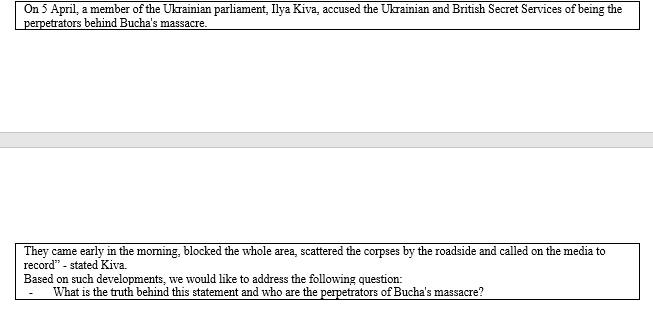
Request for Information addressed to the Embassy of Ukraine in Albania
In its response to Faktoje, the Ukrainian Embassy in Albania states that Ilya Kiva is accused of national treason.
“Ilya Kiva is not a Member of Parliament of Ukraine. Since the beginning of the war, he is in the Russian Federation territory. “Prosecutor’s Office of Ukraine has made a request as it is suspected of national treason.”
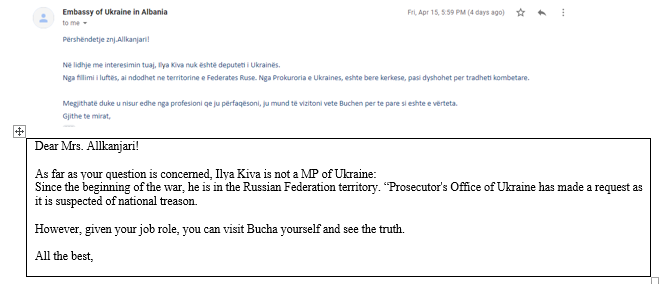
Response of the Ukrainian Embassy in Albania
Furthermore, we requested information on the Kiva’s statement from one of the fact-checking organizations in Ukraine, Stop Fake, which, same as Faktoje, is a member of the International Fact-Finding Network (IFCN).

The correspondence with the fact-checking organization ‘Stop Fake’ in Ukraine
In its response to Faktoje, the “Stop Fake” organisation shows that the group of fact-checking journalists, during the on-site observation of Bucha’s massacre, reports that the peaceful civilian population of Ukraine was subjected to extreme brutality by the Russian army.
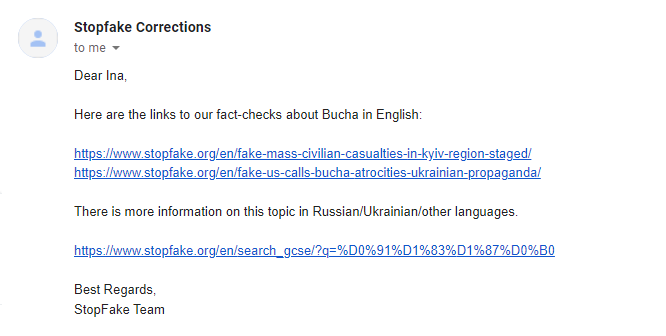
Response of the fact-checking organization ‘Stop Fake’ in Ukraine
“The peaceful civilian population of Ukraine has been undoubtedly subjected to extreme violence and brutality of Russian military. This was also confirmed by numerous testimonies of locals from Kiev’s areas who have been under Russian military occupation for a month. Some of them have already been documented by the international human rights organization “Human Rights Watch”- writes Stop Fake in one of the checking articles on the massacre.
Stop Fake organization further informed us of the verification revealing that Russian troops used violence against Ukrainian civilians and, according to them, this is undoubtedly true while emphasizing the possibilities of confirming such statement the by numerous testimonies of Kiev’s region residents.
“In particular, Mayor of Bucha, Anatoly Fedoruk reported the discovery of a mass grave where 280 civilians were buried and dozens of bodies lay in the streets; some of them with their hands tied behind their backs and with signs of torture,” – writes , among others, Stop Fake.
Faktoje also asked the Deputy Minister of Social Affairs and Technology of Ukraine, Kostiantyn Koshelenko.
In his response to Faktoje, Deputy MP wrote:
“Ilya Kiva is a scandalous pro-Russian politician who more likely to be funded by Russia and has now fled. The massacre in Bucha and Irpen was committed by regular Russian troops. All evidence was collected by the relevant Ukrainian services together with international observes and made public”.
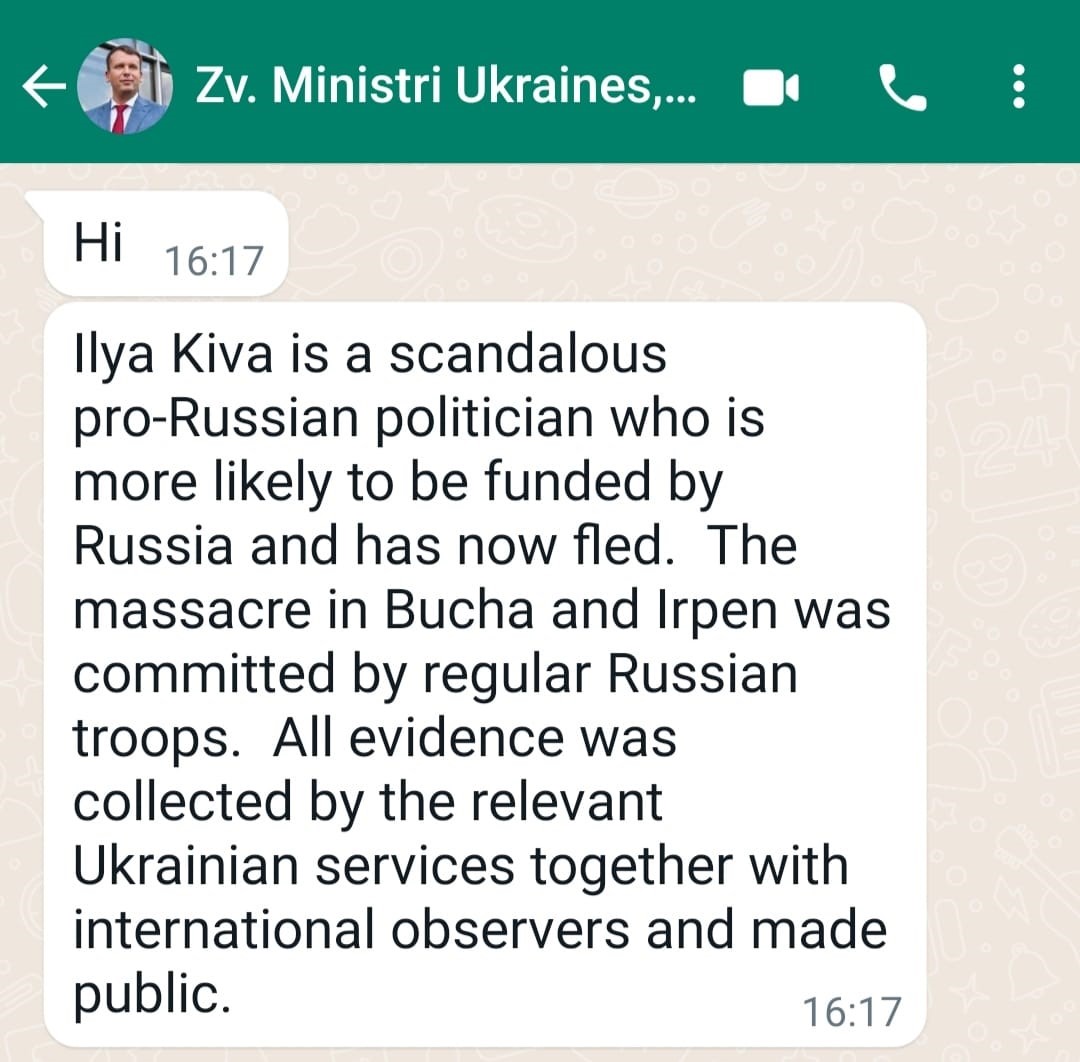
Response of the Deputy Minister of Social Affairs and Technology of Ukraine, Kostiantyn Koshelenko
The eyewitness talks about the start of the massacre in Bucha
Ukrainian sociologist and communications expert, Mr. Dmitry Gromakov, being an eyewitness of Bucha’s massacre, made a detailed description of the attack for Faktoje.
“The first checkpoints blocking the exit from Bucha appeared in early March. They were located at the western exit of the city on the Varshavskaya highway near the Epicentre Shopping Centre, on the street. During the first days, the Russian invaders tried to avoid contact with natives. “Occupier’s mobile checkpoints placed on the city streets ensured passport control and destruction of communication means of the locals,” said the Ukrainian political scientist.
Gromakov further told Faktoje that in the following days, when first victims began to be noted, it was forbidden to move the corpses from the street.
“People who were shot in their cars or just on the street near the shops were lying there. With the military situation around Bucha and Irpen deteriorating, the supplying problems of Russian invaders began along with regular raids and soldiers became increasingly angry and fiercer with the civilian population. Sometime between 6-7 March, there was talk of launching clean-up operations on Bucha’s outskirts. Russian soldiers began searching homes. If you did not open the door immediately, they would break it and people would be beaten and their food taken away. “Those who tried to resist this could have been killed in their own backyard” – added Gromakov.
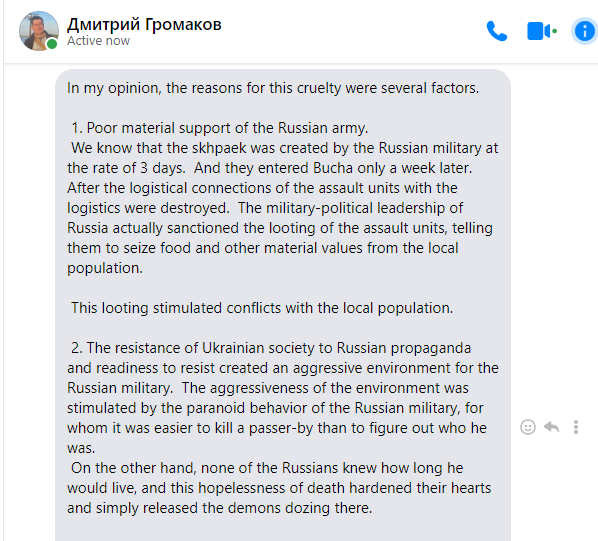
Screenshot of communication with Ukrainian sociologist and communication expert Dmitry Gromakov
According to Gromakov, the first humanitarian corridor from Bucha was very bloody. He points out that during such period, the Russian army allowed the passing of evacuation buses only, however began firing on civilian vehicles moving in a convoy.
“We left on 11 March only in the third humanitarian corridor, a few hours after the cleaning of our street began. We were forced to pass near these shot cars and dead neighbours. Exactly one week later, when Russian troops could not clearly hold Buchan and Gostomel, “Massacre in Bucha” was committed – said the Ukrainian political scientist Dmitry Gromakov for Faktoje.
Gromakov points out that the resistance of Ukrainian society to Russian propaganda and readiness to resist created an aggressive environment for the Russian military.
The aggressiveness of the environment was stimulated by the paranoid behaviour of the Russian military, for whom it was easier to kill a passer-by than to figure out who he was. On the other hand, none of the Russians knew how long he would live, and this hopelessness of death hardened their hearts. Given these reasons, the ‘Bucha Massacre’ is a war crime provoked by the inhuman policy of the Russian military-political leadership, both towards its own army and against the Ukrainians in general” – stated the Ukrainian sociologist Dmitry Gromakov for Faktoje.
Misinformation over Bucha’s massacre
Immediately after Ukrainian troops entered Bucha city, videos, photos and evidence of civilian population massacre were circulated, numerous information was published in the media around the world raising doubts whether the perpetrators of massacre were Russians, or this was staged by the Ukrainian side.
According to the Russian side, civilians in Bucha died due to artillery bombardment of the city following the withdrawal of Russian troops.
The Russian military correspondent, Mr. Alexander Kots stated on 4 April that during the city’s liberation, “the Ukrainian army fired on everything moving, especially on people with white stripes, on civilians.”

Meanwhile, satellite images published by New York Times on 4 April, show that bodies had been lying on Bucha’s streets for almost three weeks, noting that they had been killed when the city was under Russian control. Satellite images provided by Maxar Technologies for New York Times show that at least 11 bodies have been lying on the city streets since 11 March.
Another fact refuting allegations of civilian deaths during the bombings are tied hands of victims. Published images by the Ukrainian side show that the victims were killed by direct firearms.

On 5 April, the spokeswoman of UN High Commissioner for Human Rights Liz Trossel said that images and videos from Bucha clearly showed that people were direct targets being shot to death. According to her, they were shot right in the head, at a time when many of them had their hands tied.
During verifications of Bucha massacre, Faktoje found information reported by the Reuters journalist who was in Bucha and confirmed that bodies of three people were found on the city streets, shot in the head, while one of them had his hands tied. According to him, in none of these cases were other injuries found on the bodies.
The “Human Rights Watch” human rights organization has also collected eyewitness confessions of the massacre which tells about the facts of violence and killings targeted by the Russian army. Similar stories have been collected by several major world media such Radio Liberty, CNN, Reuters.



